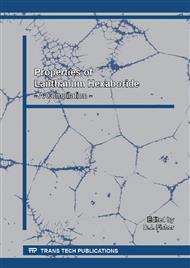[1]
Brandt W, Dupasquier A, editors. Positron solid-state physics. Amsterdam: North-Holland; 1983.
Google Scholar
[2]
Salgueiro W, Somoza A, Cabrera O, Consolati G. Cem Concr Res 2004;34:91.
Google Scholar
[3]
Jean YC. Microchem J 1990;42:72; Jean YC. Mater Sci Forum 1995;175–178:59.
Google Scholar
[4]
Dlubek G, Fretwell HM, Alam MA. Macromolecules 2000;33:87.
Google Scholar
[5]
Jean YC, Mallon PE, Schrader DM, editors. Principles and applications of positron and positronium chemistry. London: World Scientific; 2003.
DOI: 10.1142/9789812775610_0001
Google Scholar
[6]
Krause-Rehberg R, Leipner HS. Positron annihilation in semiconductors. Berlin: Springer; 1999.
DOI: 10.1007/978-3-662-03893-2_3
Google Scholar
[7]
P. Hautojsrvi. ed., Positrons in Solids (Springer, Berlin, 1979).
Google Scholar
[8]
W. Brandt, A. Dupasquier, eds., Positron Solid-State Physics (North Holland, Amsterdam, 1983).
Google Scholar
[9]
A.Dupasquier, A.P. Mills, eds., Positron Spectroscopy of Solids (North-Holland, Amsterdam, 1994).
Google Scholar
[10]
M. Eldrup. In: Defects in Solids, eds. A.V. Chadwick and M. Terenzi (Plenum, New York, 1986) p.145.
Google Scholar
[11]
M. Eldrup. J. Phys. (Paris) IV Colloq. 5 (1995) Cl-93.
Google Scholar
[12]
M.J. Puska, R.M. Nieminen, Rev. Mod. Phys. 66 (1994) 841.
Google Scholar
[13]
Troeger, L.P. and Starke, E.A., "Microstructural and Mechanical Characterization of a Superplastic 6xxx Aluminum Alloy", Materials Science and Engineering, A277, 102-113, 2000.
DOI: 10.1016/s0921-5093(99)00543-2
Google Scholar
[14]
M.A. Abdel-Rahman, M.S. Abdallah and Emad A. Badawi: Surface Review and Letters 11 (5) (2004) 427.
Google Scholar
[15]
M.A. Abdel-Rahman, M.S. Abdallah and Emad A. Badawi: Surface Review and Letters 12 (2) (2005).
Google Scholar
[16]
P. Kirkegaard, M. Eldrup, O. Mogensen and N. Pedersen: Comp. Phys. Commun. vol. 23, 1981, P. 307.
Google Scholar
[17]
A.Somoza, A.Dupasquier. Journal of materials processing technology 135 (2003) 83-90.
Google Scholar
[18]
Dupasquier , G. Kogel , A. Somoza. Acta Materialia 52 (2004) 4707–4726.
Google Scholar
[19]
C.E. Macchi , A. Somoza , A. Dupasquier , I.J. Polmear, Acta Materialia 51 (2003) 5151–5158.
DOI: 10.1016/s1359-6454(03)00364-1
Google Scholar
[20]
E. Hassan Aly , M. Mohsen and Emad M. Ahmed, Egypt. J. Solids, Vol. (31), No. (2), (2008).
Google Scholar


